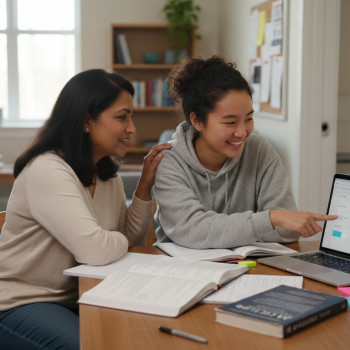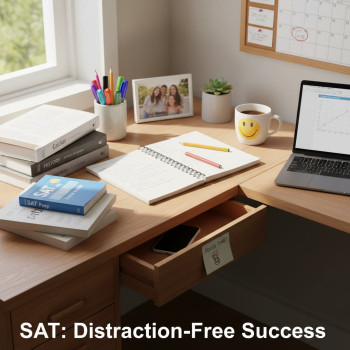Why this guide matters: SAT prep when home is anywhere
Between rotating school terms, family moves, sports seasons, music tours, and international exchanges, some students live with suitcases half-packed and classrooms in four time zones. Preparing for the Digital SAT under those conditions can feel overwhelming — logistics, time zones, and changing study environments all chip away at consistency. But travel doesn’t have to be a barrier. In fact, it can make a student a better test-taker: adaptable, quick at reset, and comfortable with unfamiliar settings. This guide gives clear, practical, and humane strategies to make SAT prep work for teens who are on the move — and for the parents supporting them.

Understand the Digital SAT basics (so planning becomes simpler)
Before building a mobile study routine, it helps to ground yourself in the essentials of the modern SAT. The digital SAT is shorter than the old paper version, offered via the official testing app, and uses a multistage adaptive design. That means the test adapts to a student’s performance across sections rather than presenting the exact same questions to everyone. Scores are still reported on the familiar 400–1600 scale and colleges receive comparable metrics, but the format shifts how you practice: think shorter timing windows, modular sections, and digital navigation rather than paper pacing.
Key features that affect traveling students
- Shorter total testing time — less sitting still, which can reduce fatigue for students who’ve been traveling.
- Bluebook (the test app) and device requirements — practice on similar devices to avoid surprises.
- Adaptive modules — early questions influence later difficulty, so early confidence helps.
- Digital score reports and mobile apps (like BigFuture) — results and resources may be easier to access while abroad.
Make a travel-friendly study plan: structure + flexibility
Travel makes rigid plans brittle. The trick is to design a study plan with firm priorities but flexible execution. Build around windows of consistency: flights, hotel mornings, long train stretches, or calm evenings. Aim for bite-sized daily practice with weekly anchors for deeper work.
Weekly blueprint for busy calendars
- Daily: 20–40 minutes of focused practice (targeted drills or Khan Academy practice) — doable in a hotel room or on a layover.
- 2–3 times per week: 60–90 minutes of mixed practice (reading passages, timed math sets) when you have a stable block of time.
- Weekly: One longer session (2–3 hours) for full-section pacing, tech troubleshooting, and reflection.
- Monthly: Full practice test on the Bluebook or official platform to simulate the digital testing environment.
How to set priorities when time is limited
When you only have 30 minutes on a train, focus on high-impact tasks: error logs, vocabulary-in-context practice, or a timed 15–20 minute math set. Save longer, more immersive work for hotel evenings or weekends. Use the ‘rule of three’: each short session should target one skill, one strategy, and one check (a quick review of mistakes).
Gear and tech: travel essentials for digital SAT success
For traveling students, technology isn’t optional — it’s central. Being deliberate about devices, backups, and test-app familiarity removes a lot of last-minute stress.
Device checklist
- Primary device: the laptop or tablet you’ll practice on (make sure it meets testing app specs).
- Backup device: a second laptop/tablet or even a school-issued device — keep it charged and updated.
- Portable battery pack and charging cables — bring one that can recharge your device at least once.
- Noise-cancelling headphones for focused practice in noisy spaces.
- Paper notebook and a pen — for scratch work and error logs (digital tests don’t allow external scratch paper at home runs, so practice the habit of neat, efficient manual work).
Practice on the same platform as test day
Download Bluebook and any official practice previews. Schedule at least three full-length practice sessions on the same device you’ll use for testing. This reduces surprises about screen size, scrolling behavior, and where the on-screen calculator appears. Practicing only on your phone is not recommended — the test app is designed for larger screens — but short, focused drills on a phone are useful while waiting in transit.

Study strategies that travel well
Good SAT prep blends content knowledge with strategy. Traveling students benefit most from approaches that fit short bursts and variable settings.
Micro-study routines
- 15-minute error review: pick 3 missed problems, rewrite them, and identify the single reason for each mistake.
- Quick concept flash: use digital flashcards for grammar rules, math formulas, or commonly confused operations.
- Reading sprints: 20-minute timed passage practice — portable and great for trains or lounges.
Chunking and spaced repetition
Break large topics into small chunks you can revisit regularly. For instance, dedicate a week to linear equations with three short sessions: concept, practice, and review. Use spaced repetition apps or a visible calendar to ensure you return to topics after 3, 7, and 14 days.
Pacing, timing, and the reality of adaptive sections
The digital SAT’s adaptive design rewards consistent accuracy. An overly rushed start can put you into a harder second module; too cautious a pace can leave points on the table. Practicing with timed modules that mimic the real sections helps students learn an optimal personal pace.
Practical pacing tips
- Warm up with 5 minutes of easier review before a timed module to get the brain moving.
- Learn to triage: if a question costs more than twice your average time, mark it, move on, and come back if time allows.
- Practice the “two-pass” approach in reading: quick read + answer, then return for deep-evidence questions.
Study spaces on the move: turning wherever-you-are into a quiet corner
Creating a repeatable ritual helps the brain switch into study mode even when the scenery changes. Small rituals — the same playlist, the same warm drink, or a particular notebook — act as anchors.
Quick checklist for a functional mobile study setup
- Find a stable surface and seat with decent lighting.
- Limit distractions: use airplane mode for study sessions that don’t require internet, or a site blocker if you’re online.
- Set a timer for short blocks so you don’t overcommit to noisy environments.
- Use physical cues — a favorite pen, specific playlist, or a study scarf — to trigger focus.
Scheduling tests and coordinating travel dates
Test date logistics matter more for traveling families. Plan early: registration windows, international vs. domestic administrations, and the time needed to build scores that reflect your best work should guide when you’ll schedule your SAT attempt(s).
Guidelines for booking dates
- Aim to complete at least one full practice test under test-like conditions 4–6 weeks before you plan to register for a real administration in order to gauge readiness.
- If you’re traveling internationally, confirm local test center availability and time zone differences well in advance.
- Build buffer time: allow for at least one retake window if your schedule allows — many students improve with a second attempt.
Social-emotional tips: staying sane, motivated, and connected
Travel is exciting but can be socially and emotionally disruptive. Keep motivation steady by setting small rewards, celebrating incremental wins, and keeping family and tutors in the loop.
Concrete ways parents can help
- Celebrate short-term achievements (a solid practice test or a streak of daily practice).
- Help maintain a consistent sleep schedule, especially in the weeks before testing.
- Be pragmatic about nutrition on travel days — protein, hydration, and a light snack before the test help focus.
When to bring in extra help: tutoring, diagnostics, and targeted support
Some students do fine on a DIY plan, but many benefit from targeted support — especially when schedules are irregular. Personalized 1-on-1 tutoring can provide tailored study plans that fit travel windows, accountability during inconsistent weeks, and the ability to adapt strategies quickly after each practice test.
What to look for in travel-friendly tutoring
- Flexible scheduling that can accommodate time zones and short-notice changes.
- Short, high-impact sessions focused on immediate weaknesses rather than generic lessons.
- Use of digital tools to share practice materials, error logs, and progress tracking across devices.
Services like Sparkl offer personalized tutoring with 1-on-1 guidance, tailored study plans, expert tutors, and AI-driven insights to help busy teens focus on what truly moves the score needle, even when the calendar is unpredictable.
Sample travel-friendly weekly schedule
The table below illustrates a balanced week for a traveling student with variable days. Adjust durations up or down based on available time and energy.
| Day | Morning (30–45 min) | Afternoon / Transit (15–30 min) | Evening (45–90 min) |
|---|---|---|---|
| Monday | Vocabulary + grammar drill | Short reading passage | Targeted math practice (algebra focus) |
| Tuesday | Timed reading section | Error log review | Live tutor session (45 min) or recorded lesson |
| Wednesday | Quick math formulas warm-up | Flashcards (concepts) | Full timed section (reading or math) |
| Thursday | Grammar rules + practice | Short mixed-problem set | Review of missed problems + strategy notes |
| Friday | Mini practice test (module) | Relaxed reading (non-fiction) | Optional tutor check-in or rest |
| Saturday | Full math practice set | Travel downtime: light review | Personal reflection: progress and goals |
| Sunday | Full practice test (monthly) | Rest and recreation | Plan next week |
Real-world examples: two student profiles
Case A — The competitive swimmer
Sam trains with early-morning practices and travels for meets on weekends. Their prep focuses on short early-morning review sessions, two weekly tutor sessions scheduled around meets, and using recovery travel time to do passive reading practice. Sam’s tutor helps calibrate pacing so that missed sleep or travel stress won’t derail performance.
Case B — The exchange student
Amira is studying abroad for a semester. Time zones mean her school day ends when family at home is asleep. She schedules midday study blocks that align with her body clock, uses a local quiet café as a weekly study anchor, and shares digital error logs with a tutor who can give asynchronous feedback. She also practices on the same device she’ll use for test day to avoid last-minute tech issues.
Test day for travelers: logistics and mindfulness
Test day feels different when you’re away from home. Pack a test-day kit (ID, device power, backup charger, snacks, medication, and a printed copy of test admission instructions if available). Aim to arrive early so you can settle. If you crossed time zones recently, give yourself a light rehearsal session the day before — a short, low-stakes module to build confidence.
Mindset practices to keep calm
- Breathwork: a 3–4–5 breathing routine for two minutes before starting.
- Visual cue: a quick memory of a place where you felt steady (a park bench, a kitchen table) to anchor calm.
- Routine: same breakfast and 10-minute walk whenever possible.
Measuring progress and knowing when to retake
Use monthly practice tests and the error log as objective measures. Look for consistent improvements in accuracy and pacing. If scores plateau, shift focus from quantity to quality: targeted remediation on weak content areas, strategy work, and timed exposure. If a practice test indicates you’re close to your target, a retake after another focused 4–6 week cycle often yields gains.
Final thoughts — travel is not a handicap, it’s a context to master
Traveling changes how you prep, but it doesn’t stop you from achieving a strong SAT score. With a portable toolkit — reliable tech, micro-study habits, laser-focused tutoring when needed, and compassionate support from parents and mentors — students who travel can prepare as effectively as anyone. Build a plan that respects unpredictability, choose habits that travel well, and lean on targeted help when life gets busy. If you’d like a partner who understands the realities of a mobile life, personalized options like Sparkl’s 1-on-1 guidance, tailored study plans, expert tutors, and AI-informed progress tracking can make the journey smoother and more efficient.
Take a breath. Pack a charger. And remember: consistency, not perfection, wins the test.

















No Comments
Leave a comment Cancel